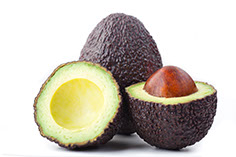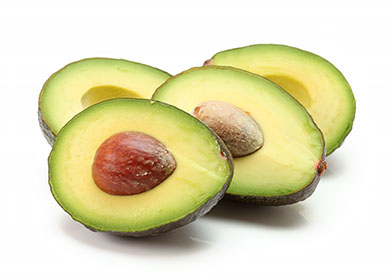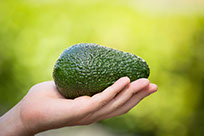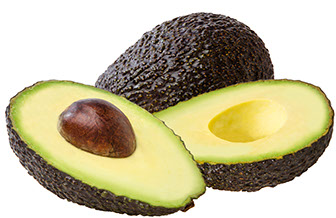
Overview
Compatibility & Temperature
Grade Tolerances
Nutrition Information
Avocados
The Avocado is thought to have originated in Southern Mexico, but the fruit was cultivated from the Rio Grande down to central Peru before the Europeans arrived in the New World. The fruit grows on trees that can reach 60 feet or higher, but typically stand about 30 feet tall. Most varieties are pear-shaped and can range in skin color from yellow-green to green to a dark purple that is almost black in appearance. Skin texture ranges from smooth to bumpy while the flesh of the fruit is typically a buttery yellow or yellow-greenish color depending on variety. In the middle sits a single seed, from 2 to 2.5 inches long, which can vary in shape but are usually hard and heavy with ivory coloring beneath papery-thin brown seed coats.
Sources: Purdue University, University of California

Characteristics
Avocados are sensitive to rough handling; as a result, fruit is no longer detached by a forked stick to fall on the ground. For lower fruit, clippers are used, and for those higher up in trees, a long-handled stick with a V- shaped cutter is used to cut the stem. Fruit then falls into a sturdy cloth bag. Workers wear gloves to avoid scratching the fruit, which is then packaged in padded boxes or cartons or molded trays.
Temperature:
Optimum temperature for mature green avocados (depending on variety) is 41 to 55oF (5 to 13oC) and 36 to 40oF (2 to 4oC) for ripe fruit with 90 to 95% relative humidity. Avocados produce ethylene after harvest, which increases significantly as they ripen. Treating avocados with ethylene can induce ripening in 3 to 6 days depending on the variety and maturity. Controlled atmospheres will delay softening and reduce ethylene production.
Sources: Purdue University, Texas A&M University, UC Davis Postharvest website
Good Arrival Guidelines:
Good arrival guidelines in the United States for avocados permit 15% total average defects, 8% serious and 3% decay upon arrival at contract destination after
Know Your Commodity — Avocados Page 2 of 2 Published by Blue Book Services
five-days in transit. Currently, there are no good arrival guidelines specific to Canada for avocados.
Recommended transit temperature de- pends on the variety, but generally ranges from 40 to 55oF.
Sources: DRC, PACA, USDA

Nutrition Facts
Serving Size 1 avocado, NS as to Florida or California
Amount Per Serving
Calories from Fat 265Calories 322
% Daily Values*
Total Fat 29.47g 45%
Saturated Fat 4.273g 21%
Polyunsaturated Fat 3.65g
Monounsaturated Fat 19.696g
Cholesterol 0mg 0%
Sodium 14mg 1%
Potassium 975mg
Total Carbohydrate 17.15g 6%
Dietary Fiber 13.5g 54%
Sugars 1.33g
Protein 4.02g
Vitamin A 6% Vitamin C 34%
Calcium 2% Iron 6%
* Percent Daily Values are based on a 2000 calorie diet. Your daily values may be higher or lower depending on your calorie needs.
Nutrition Values are based on USDA Nutrient Database SR18

Century Farms International, Inc.
10957 NW 123rd Street Medley, FL 33178
Office: 305-436-7971 Fax: 305-436-7968




